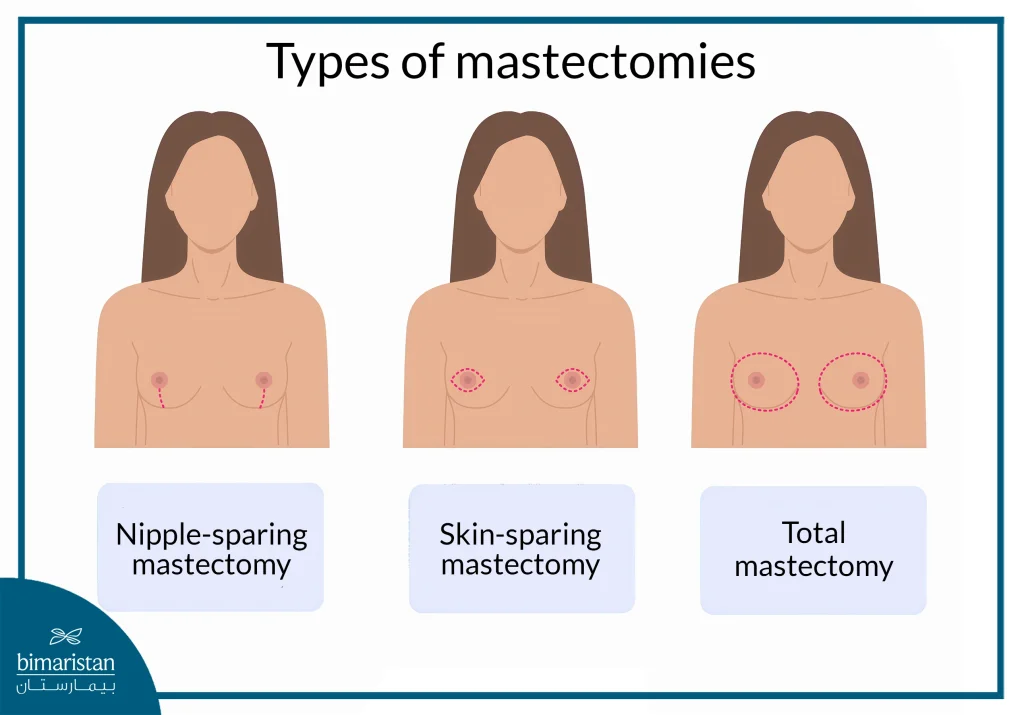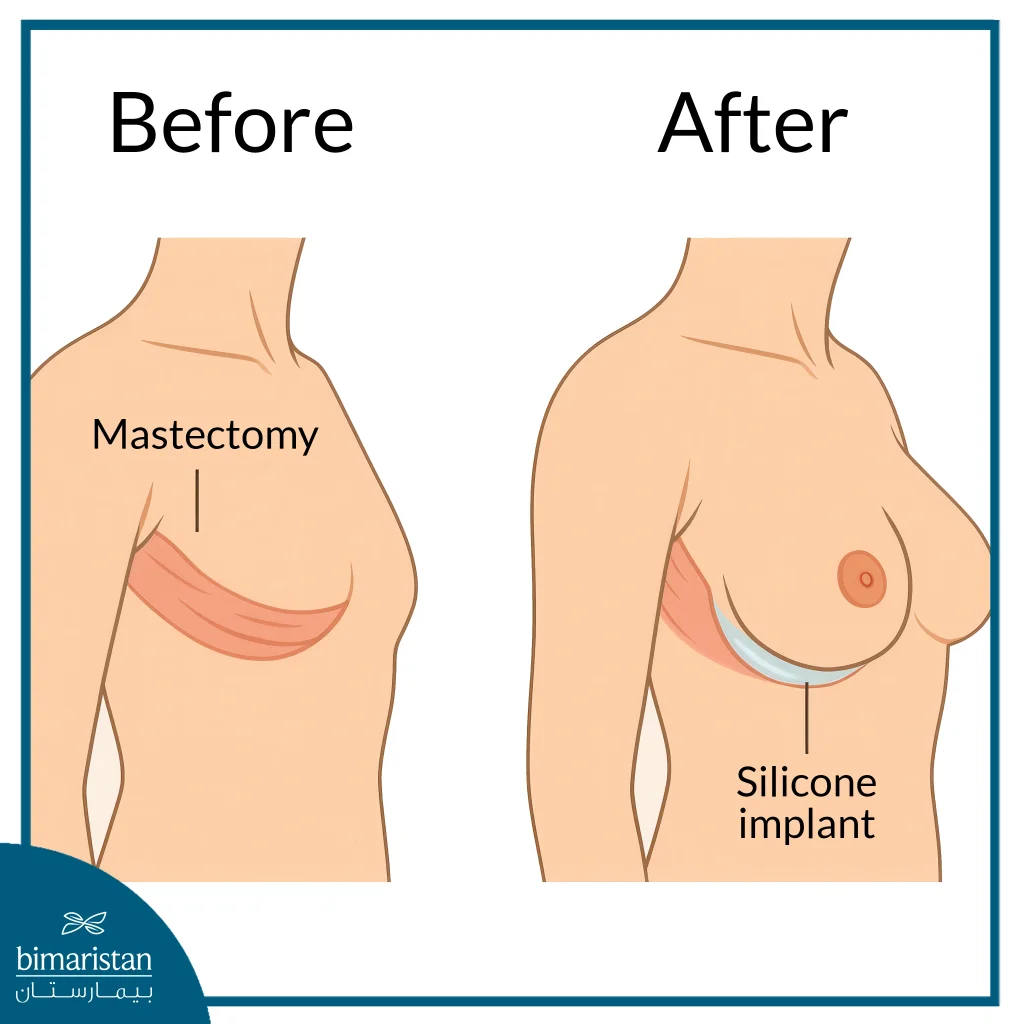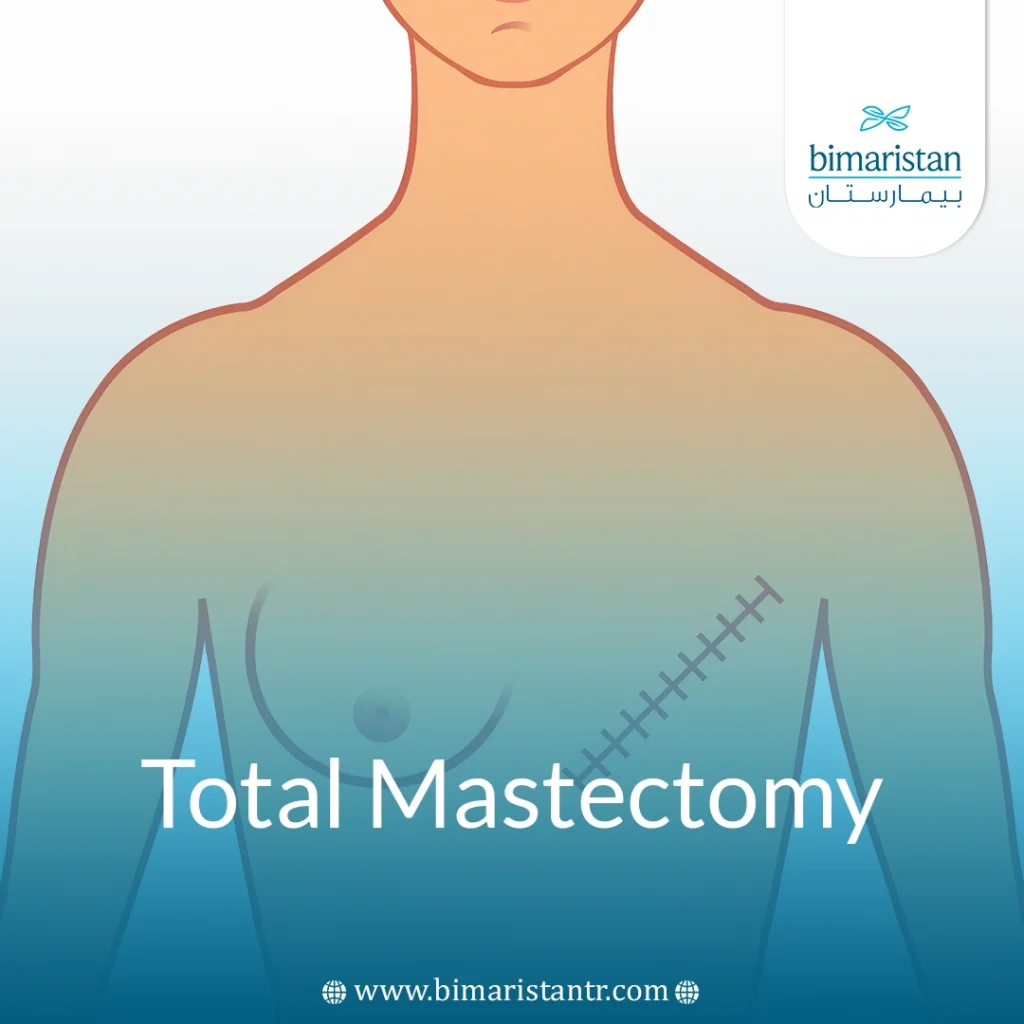In a watershed moment, a woman may find herself facing a fateful decision: a total mastectomy, which is the difference between illness and life. In this article, we learn why a total mastectomy is performed, along with an overview of the reasons for the surgery and its impact on the patient’s life.
What is a total mastectomy?
Total mastectomy is a type of breast surgery to treat breast cancer, in which the entire breast tissue is removed, in one or both breasts, while sparing the chest muscles. This surgery is used to treat most types and stages of breast cancer, and can also be performed as a preventive measure if the risk of breast cancer is high. Partial mastectomy is a conservative surgery that aims to remove the tumor with a margin of healthy tissue surrounding it, and is an option when treating early-stage breast cancer.
Types of total mastectomy surgery
There are several types of mastectomy surgery, and the doctor chooses the right one based on the patient’s condition and the degree of cancer development, taking into account cosmetic reasons.
Traditional total mastectomy
In this type, the surgeon makes an oval incision and removes all breast tissue, including the nipple, areola, and a large part of the breast skin. The initial incision is carefully selected, allowing for adjustment after the breast is removed. The width of the oval incision varies according to the size of the breast, ensuring proper closure without sagging or excessive tension. This is achieved by avoiding the removal of any muscles under the breast. The operation will leave a scar in the place of the removed breast, and if the case is diagnosed with breast cancer, the surgeon will remove one to three lymph nodes for histological examination.
Skin-sparing mastectomy
In this type, the surgeon makes an oval incision similar to the previous type but removes the entire breast tissue along with the nipple and areola while preserving the breast skin, as this procedure allows for a more natural result when reconstructing the breast, nipple, and areola, and leaves a scar across the center of the breast.
Nipple-sparing mastectomy
The surgeon makes a lateral, inferior breast crease or periareolar incision and removes only the breast tissue while preserving the nipple, areola, and skin. Still, this type cannot be performed if the breast cancer is in or near the nipple or if the breast is large and drooping.

Conditions that require a total mastectomy
There are several conditions that require a total mastectomy, some of which are for the treatment of breast cancer or to treat other diseases:
- Ductal carcinoma in situ (DCIS), also known as non-invasive breast cancer
- Stage I and II (early-stage) breast cancer
- Cancer that returns after treatment is known as locally recurrent breast cancer
- In some cases, after chemotherapy such as stage III breast cancer and inflammatory breast cancer
- Extensive calcium deposits
- When Paget’s disease is present in the breast
Total mastectomy in both breasts is known as prophylactic mastectomy and is performed in the following cases:
- Having gene mutations (BRCA1/BRCA2) that increase the risk of breast cancer
- Breast cancer prevention in high-risk patients with a strong family history of breast cancer
Preparing for a full mastectomy
The patient will develop a comprehensive treatment plan with the doctor that includes the type of procedure she will undergo, as well as any reconstructive surgery the patient may want to have later, and the patient will learn what to expect during the recovery period. It is also possible to connect with local support groups for breast cancer patients by talking with patients who have gone through the mastectomy experience, which reduces the patient’s anxiety about the surgery and recovery.
The doctor will also request some tests, such as a blood test and some radiographs. The doctor may ask the patient to quit smoking before the operation, which negatively affects the blood flow, slowing down the wound healing process. The patient may not be eligible for reconstructive surgery if she is a smoker. In addition, the doctor may ask the patient to fast for several hours before the operation.
Steps to a full mastectomy
The steps of a total mastectomy include the following:
- The patient is given general anesthesia, meaning she will be asleep throughout the procedure
- A breathing tube and intravenous catheter are inserted to give the patient fluids to keep the body hydrated during the procedure, and a urinary catheter may be placed to drain urine.
- The surgeon will sterilize the skin and give the patient antibiotics to reduce the risk of infection.
- Your surgeon may inject a mild radioactive substance in order to identify nearby lymph nodes using a hand-held scanner.
- The surgeon removes all of the breast tissue, which may include removing or preserving the skin or nipple, depending on the type of surgery.
- The surgeon may remove some lymph nodes for examination, which is sent to a lab to detect the presence of cancer cells.
- If the patient chooses to have breast reconstruction surgery, the surgeon may begin and complete it in the same operation, or may use an implant, a temporary implant, or tissue taken from elsewhere in the body.
- The doctor will eventually close the incision and most likely leave a temporary drainage tube in order to drain the excess fluid into an external bag, which usually remains for one to two weeks after the procedure.
Complications of a total mastectomy
Any surgical procedure is not without complications and risks, and complications of a full mastectomy include the following:
- Infection: Surgeons take great care to prevent them, and they are less than 1% less likely to occur.
- Seroma: Occurs when fluid builds up inside a wound, causing localized swelling and pain.
- Hematoma: This is a rare complication that occurs when blood collects under the wound.
- Permanent pain or loss of sensation: Known as post-mastectomy pain syndrome (PMPS), it is caused by nerve damage and causes symptoms such as numbness, tingling, and burning.
- Scars and their cosmetic effect, as well as the psychological trauma after resection.
Recovery and care after total mastectomy surgery
The patient usually stays in the hospital for 1-2 days, and the wound heals in about 3 weeks. The doctor will explain to the patient how to care for the wound and drainage tube at home, and when it is safe to shower. The patient may feel tired, pain, and stiffness in the chest, shoulder, and arm area for up to 6 weeks, and the patient may not be able to use the affected arm to lift or carry heavy objects during this period. Still, mild pain relievers can be used to relieve discomfort, such as Sitamol, and simple exercises can be performed to avoid stiffness.
As for the nerves, they are the slowest part of the body to recover; the patient may feel numbness and some tingling, and many women regain part of the sensation in the chest within two years. Still, full sensation may not return, and it is common for partial permanent numbness to remain. The doctor may recommend talking to a psychologist or joining a support group to help the patient cope with the experience.
Can breast reconstruction be done?
Breast reconstruction after mastectomy, also known as breast reconstruction, can be done either immediately (at the same time as the mastectomy) or delayed (after completing additional treatments such as radiation and chemotherapy). Reconstruction options include:
- Tissue expanders and silicone implants: A temporary expander is placed under the skin or muscle, gradually filled with saline to expand the tissue, and then replaced with a permanent silicone implant.
- Autologous tissue reconstruction: Tissue taken from other areas of the body, such as the abdominal muscle, is used to reshape the breast. This method is more natural looking and feeling, but is longer and more surgically complex.
To summarize, artificial implants are less time-consuming in surgery and recovery but may require long-term replacement and may not be ideal after radiation therapy, while autologous muscle reconstruction gives more permanent results and a natural appearance, especially in cases of previous radiation, but requires a longer recovery time and possible complications at the graft site.

Life after a total mastectomy
After a total mastectomy, the patient goes through physical and psychological changes that affect her daily life. She may experience temporary pain, stiffness in the shoulder or arm, and difficulties in practicing some activities, which requires modifying the daily routine temporarily, as regular medical follow-up is necessary to monitor the surgical site and early detection of any signs of tumor recurrence.
Family and close family support is crucial in fostering a sense of safety and reassurance, specialized psychological support helps in adjusting to physical changes and a new self-image, and joining support groups for women who have gone through the same experience provides an encouraging environment, reduces feelings of isolation, and enhances the ability to cope and recover.
In the end, a total mastectomy is a necessary treatment step in some cases, but it is not the end of the road; with awareness, support and advanced medical care, patients can confidently and safely regain their lifestyle.
Sources:
- National Center for Biotechnology Information. (2019). Mastectomy. In StatPearls. StatPearls Publishing.
- National HealthService. (n.d.). Mastectomy. NHS.
- Cancer Australia. (n.d.). Mastectomy. In Cancer Australia: Breast cancer treatment options – Surgery

